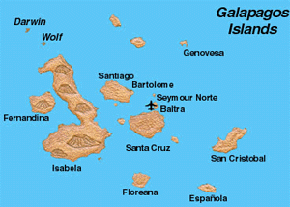| THE
ISLANDS |
|
|

|
| GENOVESA
: |
| The island is a tip
of a sumerged volcano that rises76 meters above the sea level.genovesa
is a very dry island with characteristics vegetation because of its isolated
position.However it is a paradise for sea birds,including larges colonies
of the red footed boobies and great frigate birds |
| ISABELA : |
| This island was formed
by five independent volcanoes that came together to form the largest of
the islands and has the highest elevation as well. The northwest coast
of the island is a sanctuary for whale,along with moderate hikes to Darwin
Lake make this visit worthwile |
| SANTIAGO : |
| It is the fouth largest
island and has main volcano rises. All vegetation zones, from costal to
humid are present. Santiago is one of the best islands to see fur seals
and hawks |
| FERNANDINA
: |
| The colosal shield
of Fernandina volcano reaches 1494 m and is still very active. Its vegetation,typical
of arid zone is concentrated in "Kipukas" (small areas left
untouched by recent lava). It also provides a broad variety of wildlife
and volcanic features |
| SANTA CRUZ
: |
| The second largest
of the Archipelago and colonized since the 1920's ,Puerto Ayora, the populated
part of the island, is the most important harbor of the Archipelago. The
headquarters of the Galapagos National Park and the Charles Darwin Station
are located on Sta Cruz |
| SANTA FE
: |
| This island is the
result of an uplifting that raised the sea floor 259 meters above the
sea level. The vegetation of the island is characterized by the presence
of the largest species of the giant opuntia cactus |
| FLOREANA : |
| An island with a
gentle landscape dominated by parasitic cones. If a volcano ever existed,
it has eroded, long ago. It was the first inhabited island of the Archipelago
where flamingos can be found |
| ESPAÑOLA : |
| The island is relatively
flat and some geologists describe the island as the remains of an eroded
archaic volcano. The vegetation corresponds to arid and transition zones
with the most spectacular sites and interesting wildlife |
| SAN CRISTÓBAL
: |
| The southwestern
half of this island is inhabited and is formed by an extinct volcano.
The other half of the island,the northeastern part, contrast dramatically,
with flat, dry and harsh environments. The San Cristobal Interpretation
Center was donated by the Spanish government in 1998. |
